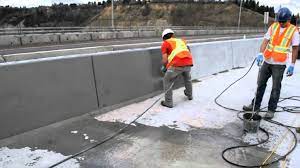Concrete, once relegated to its utilitarian role in construction, has evolved into a versatile and aesthetically pleasing material in modern architecture. Among the various finishing techniques, the rubbed concrete finish stands out for its ability to transform the raw and robust nature of concrete into a refined and elegant surface. This article explores the characteristics, applications, and artistry behind rubbed concrete.
1. Defining the Rubbed Concrete Finish:
The rubbed concrete finish involves the careful manipulation of the concrete surface to achieve a smooth and polished appearance. Skilled craftsmen use abrasive tools, such as grinding stones or polishing pads, to refine the surface texture, revealing the aggregate beneath and creating a sleek, sophisticated finish.
2. Characteristics of Rubbed Concrete:
- Smooth Texture:
- The defining characteristic of a rubbed concrete finish is its smooth and refined texture. The abrasive tools used during the process gradually remove imperfections and roughness, resulting in a polished surface.
- Aggregate Exposure:
- The rubbing process exposes the aggregate within the concrete mix. This can range from fine sand to larger stones, adding visual interest and texture to the finished surface.
- Variable Finish Options:
- Depending on the desired aesthetic, the level of grinding and polishing can vary. A light rubbing may result in a matte finish, while more intensive rubbing can produce a glossy surface.
- Color Enhancement:
- Rubbed concrete finishes often enhance the natural color of the concrete, bringing out its inherent tones. This can be particularly appealing when working with colored or stained concrete.
3. Applications of Rubbed Concrete Finish:
- Interior Flooring:
- Rubbed concrete finishes are popular choices for interior flooring in residential and commercial spaces. The smooth surface provides a sleek and contemporary look, while the exposed aggregate adds character.
- Countertops and Surfaces:
- In kitchens and bathrooms, rubbed concrete finishes are applied to countertops and surfaces, offering a durable and visually appealing alternative to traditional materials.
- Architectural Elements:
- Rubbed concrete finishes are employed on various architectural elements, including feature walls, fireplace surrounds, and staircases. The versatility of the finish allows it to complement both modern and traditional design styles.
- Exterior Facades:
- While less common due to exposure to weathering, some architects and designers use rubbed concrete finishes on exterior facades to create a distinctive and textured look.
4. Artistry and Craftsmanship:
- Skillful Application:
- Achieving a flawless rubbed concrete finish requires a high level of skill and precision. Craftsmen must carefully control the grinding and polishing process to ensure a consistent and aesthetically pleasing result.
- Customization and Creativity:
- The artistry in rubbed concrete finish lies in its customization. Designers can experiment with different aggregate exposure levels, color enhancements, and glossiness to create unique and personalized surfaces.
- Incorporating Design Elements:
- Craftsmen can incorporate design elements, such as patterns or borders, into the rubbed concrete finish. This allows for a high degree of creativity and personalization in architectural and interior design projects.
5. Maintenance and Longevity:
- Durable and Low Maintenance:
- Rubbed concrete finishes are known for their durability, making them suitable for high-traffic areas. The smooth surface is easy to clean and maintain, requiring minimal effort to preserve its aesthetic appeal.
- Longevity of Appearance:
- Unlike certain surface coatings that may wear over time, a well-executed rubbed concrete finish maintains its appearance and elegance for an extended period.
Conclusion:
The rubbed concrete finish is a testament to the evolution of concrete from a basic construction material to a refined and artistic element in contemporary design. Its smooth texture, aggregate exposure, and variable finish options contribute to its popularity in a range of applications, from flooring to architectural features. The artistry and craftsmanship involved in achieving perfect rubbed concrete add a touch of elegance and sophistication to modern architecture, bridging the gap between functionality and aesthetics in the built environment. As designers continue to explore the creative possibilities of concrete, the rubbed finish stands as a timeless expression of the material’s potential for beauty and refinement.

